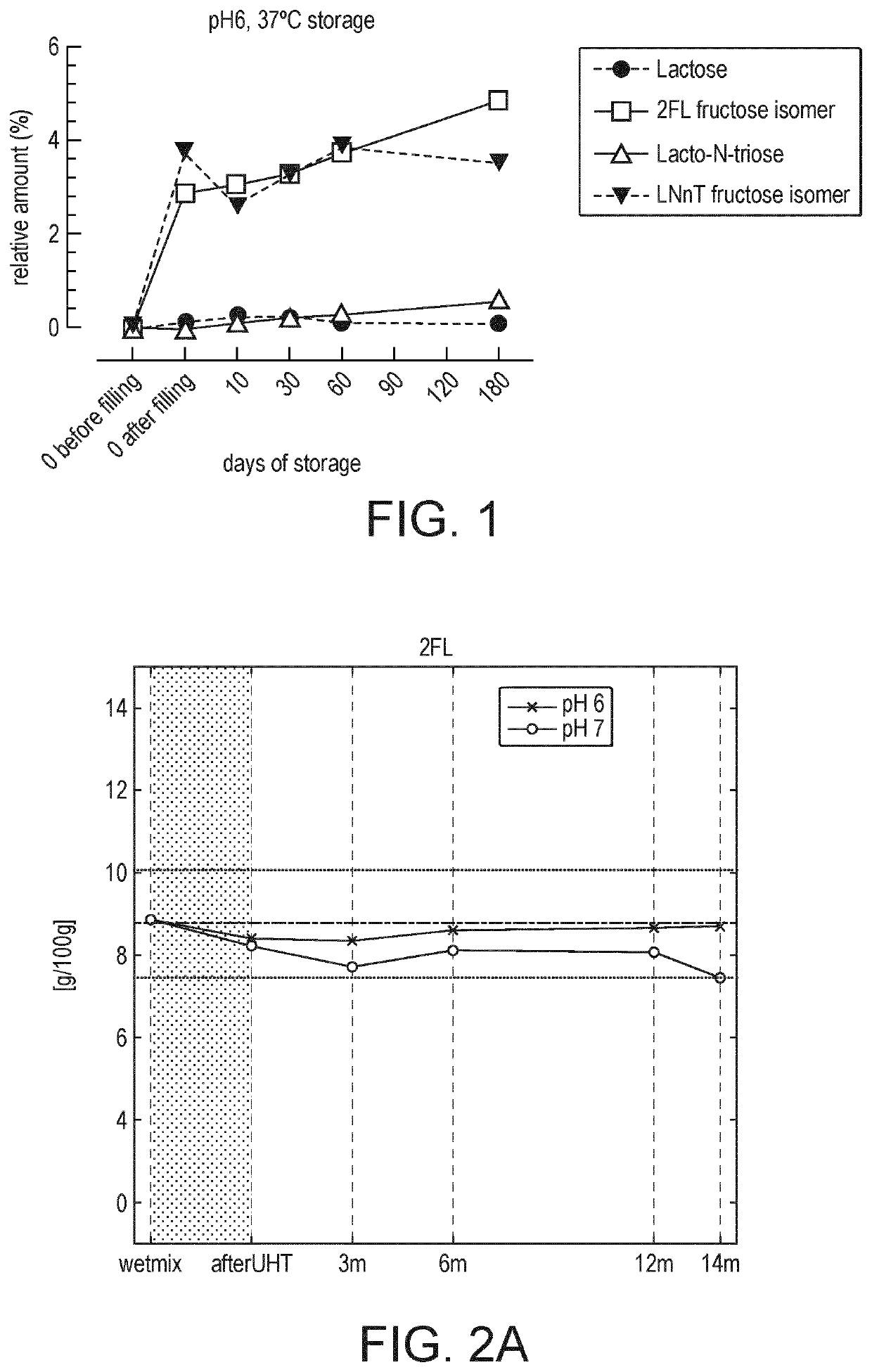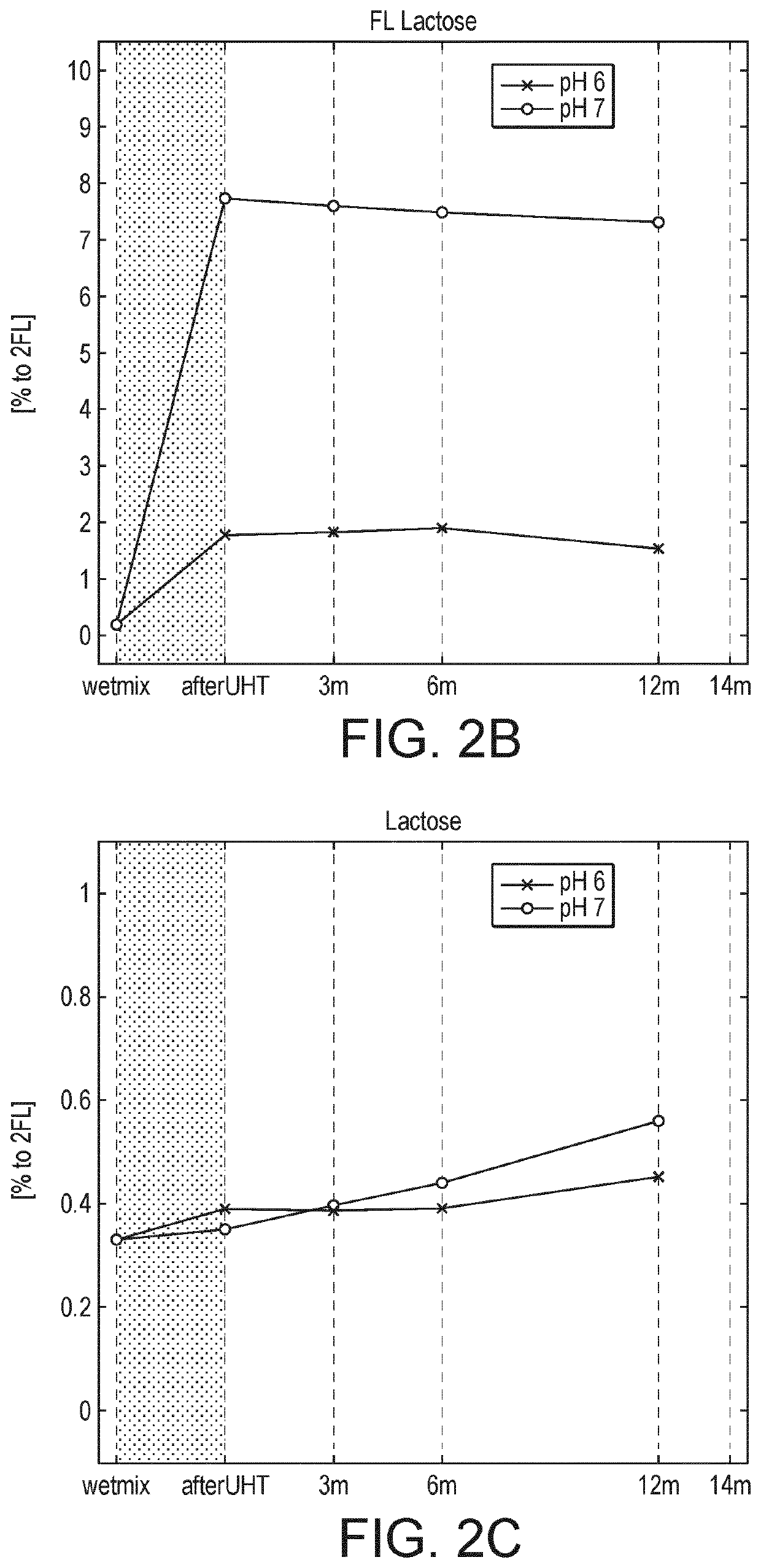Stable aqueous composition comprising oligosaccharides
a technology of oligosaccharides and aqueous compositions, which is applied in the direction of food ingredients as ph modification agents, food ingredients as buffering agents, etc., can solve the problems of insufficient concentration of oligosaccharides, inability to concentrate oligosaccharides in sufficient quantities, and inability to achieve sufficient concentration of oligosaccharides in aqueous compositions, etc., to achieve the effect of preventing hydrolysis
- Summary
- Abstract
- Description
- Claims
- Application Information
AI Technical Summary
Benefits of technology
Problems solved by technology
Method used
Image
Examples
example 1
[0150]Oligosaccharides 2′Fucosyllactose (2′FL) and Lacto-N-neotetraose (LNnT) were mixed in a 2:1 ratio (w / w) and dissolved in water to a final concentration of 10% (w / v). Solutions were acidified to pH 6 with citric acid and subjected to heat treatment (UHT) followed by aseptic filling of small monodose bottles. Solutions were analysed before and after filling of bottles as well as after different times of storage at 37° C. (accelerated storage condition).
[0151]Analysis was done by HPLC using a TSK gel Amide-80 (150 mm×4.6 mm, particle size: 3 μm) column and detection via a charged aerosol detector. For the fructose isomers of the added 2′FL and LNnT as well as for their degradation products (fucose, lactose and Lacto-N-triose) quantification was done using the relative response of the oligosaccharide to a standard curve. Fucose, Lactose, 2FL, LNnT, 2′-fucosyl-lactulose and LNnT fructose isomer were used as standards. Lacto-N-triose contents were calculated with the calibration cur...
example 2
[0153]Oligosaccharides 2′Fucosyllactose (2′FL) and Lacto-N-neotetraose (LNnT) were mixed in a 10:1 ratio (w / w) and dissolved in water to a final concentration of 10% (w / v). Out of this solution, three samples were generated respectively having pH 6 and 7 (by addition of KOH) Such samples were subjected to heat treatment (UHT) followed by aseptic filling of small monodose bottles. Solutions at different pHs were analysed before and after filling of bottles as well as after different times of storage at room temperature (21-26° C.). Analysis was done by HPLC using a TSK gel Amide-80 (150 mm×4.6 mm, particle size: 3 μm) column and detection via a charged aerosol detector. F or 2′FL (FIG. 2a), LNnT (FIG. 2d), the fructose isomers of the added 2′FL (indicated as FL lactulose in the graphs, FIG. 2d) and of added LNnT (indicated as LNnT isomer in the graphs, FIG. 2e) as well as for their degradation products (lactose, FIG. 2c). The pH of the solution was also measured. All data are express...
example 3
[0156]Oligosaccharides 2′Fucosyllactose (2′FL) and Lacto-N-neotetraose (LNnT) were mixed in a 10:1 ratio (w / w) and dissolved in buffered water (phosphate buffer as before defined) to a final concentration of 10% (w / v). Solution is submitted to a sterile filtration and filled in plastic monodose unit. Resulting pH of the solution before and after sterile filtration was around 6.
PUM
 Login to View More
Login to View More Abstract
Description
Claims
Application Information
 Login to View More
Login to View More - R&D
- Intellectual Property
- Life Sciences
- Materials
- Tech Scout
- Unparalleled Data Quality
- Higher Quality Content
- 60% Fewer Hallucinations
Browse by: Latest US Patents, China's latest patents, Technical Efficacy Thesaurus, Application Domain, Technology Topic, Popular Technical Reports.
© 2025 PatSnap. All rights reserved.Legal|Privacy policy|Modern Slavery Act Transparency Statement|Sitemap|About US| Contact US: help@patsnap.com



